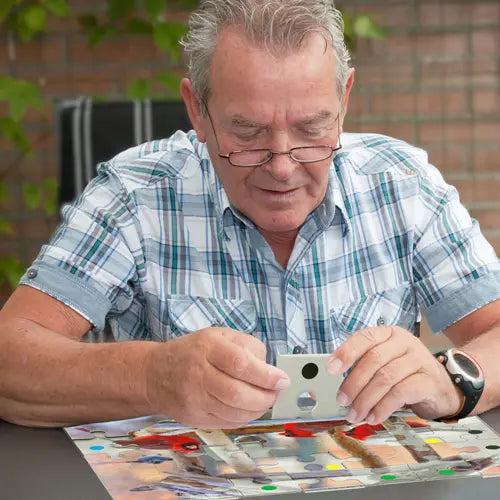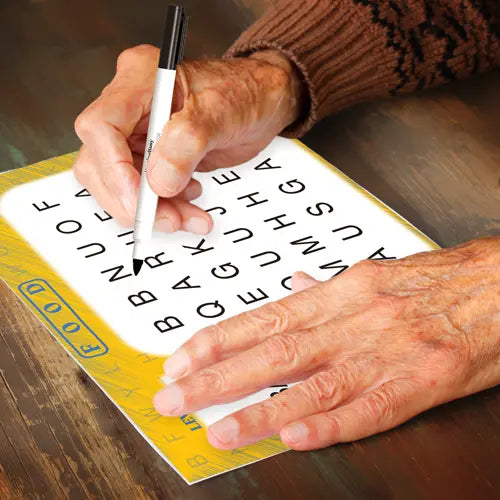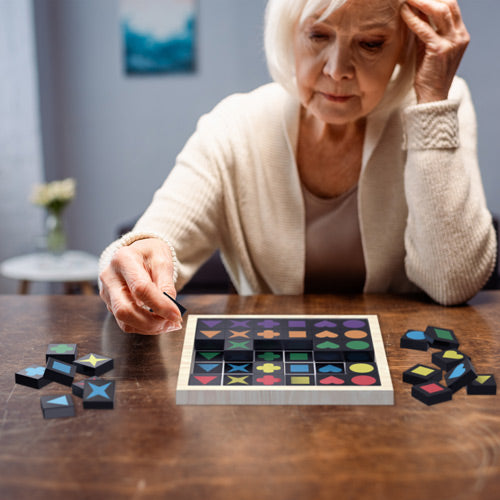
Jigsaw puzzles are a popular pastime for many people. They are an inexpensive form of entertainment that can provide hours of challenge and engagement. They also provide a multitude of benefits including exercising visual perception and fine motor control, and practicing project completion and patience. For most people, these benefits go unnoticed but for someone with dementia or Alzheimer’s they can be significant. It is these benefits combined with the sense of accomplishment that comes with completing the jigsaw puzzle that make a properly selected jigsaw puzzle an excellent activity for someone with dementia, whether or not they did puzzles on a regular basis in the past.
If a person did jigsaw puzzles as a hobby for a long period of time, they will probably have “overlearned” the skills necessary to complete a puzzle. Overlearning occurs when something has been done so often that it happens automatically, without conscious thought. These overlearned skills are often spared as the dementia progresses, and can make it easier for the person to be successful in completing the puzzle.
When someone is a puzzle aficionado they look for the most challenging puzzles – puzzles with hundreds or thousands of pieces, irregularly shaped pieces and images that have little color variation such as a lot of clouds or grass, or aspects of the image that repeat over and over. These are all ways that the person can make the activity more challenging and last longer.
As a person’s abilities decline because of the damage caused by dementia, these same characteristics are the ones that we want to avoid in choosing a puzzle. The idea is to allow the person to continue (or re-ignite) their interest in a favorite pastime and get the benefits of an engaging activity. The purpose is not to engage them for hours at a time, nor challenge them to the point of frustration. The idea is to provide an activity that they find enjoyable and can complete successfully, which then gives the person a sense of accomplishment and satisfaction and helps their self-esteem.
As with any activity, when choosing a jigsaw puzzle for someone with dementia, it is important to consider their interests, skills, needs and abilities. If the person has mild cognitive impairment or is in the very early stages of dementia, they may still be doing 700 or 1000 piece puzzles. You may notice that they are not completing the puzzles, or they are getting frustrated while working on them. If this is the case, it is possible that simply choosing a puzzle with fewer pieces than they have done in the past and/or selecting an image that has distinct color variations will be appropriate. You could also try a 400 piece “family puzzle” that offers different sized pieces within the same puzzle. This has the benefit of allowing the person to work on a section of the puzzle that reflects the level of difficulty that they are comfortable with at any given time. The important thing is to find the appropriate puzzles before the person becomes too frustrated and loses interest in doing puzzles at all.
If the person hasn’t done puzzles in a long time, or if they never did puzzles as a regular activity, a different approach is required. It is important to choose a puzzle that will allow the person to successfully complete the puzzle on their own so that they gain a feeling of accomplishment and satisfaction. It is better to start with a puzzle that is too easy and move to a more difficult puzzle once the person has been successful, rather than start with a puzzle that is too difficult that may lead to frustration. It is also good to choose a puzzle that is designed for people with dementia - adult in nature and offering aids to help the person complete it so that you can provide more or less assistance depending on how successful the person is.
Our 35 Piece Sequenced Puzzles are a good starting point for jigsaw puzzles on line. The pieces are pre-sorted into color coded bags that match color coding on the puzzle tray. Initially offer only one bag of pieces. If the person is able to place them readily, try offering two or more bags at a time, increasing the number of pieces as long as they are successful at placing them on their own.
You may also want to consider puzzles other than jigsaw puzzle games. There are many jigsaw puzzle apps available for tablets and computers that offer many of the benefits of jigsaw puzzles in a different format. As always, start simple – add difficulty only after the person has been successful on their own.
Another option are puzzles that offer a sensory aspect in addition to the cognitive benefits of a jigsaw puzzle. Puzzles such as the Tangram allow the person to make shapes using the pieces by following the full sized templates or make their own creations.
The bottom line in choosing a puzzle for someone with dementia or Alzheimer’s is to consider the person’s interests, skills, needs and abilities. Choose a puzzle with an image of something that is of interest to the person, that has an appropriate level of difficulty and can be completed successfully. Because a person's abilities may vary from day to day, it is a good idea to have a choice of puzzles that offer different levels of difficulty. We can’t emphasize enough that in choosing a jigsaw game, err on the side of too easy rather than too hard. More damage will be done if the person is frustrated by the experience than if they find it too easy. Now that you've selected an appropriate puzzle, learn how to present it effectively in our article "Success with Jigsaw Puzzles for Someone with Dementia"





I pre-make all puzzles for my mom and then devide them in sections and put the pieces in numbered envelopes. This way she can open one evelop at a time to make just the next section of the puzzle. The advantage is that she can still complete big puzzles with many pieces with the ease of making a low-number of pieces puzzle. She progresses so rapidly with making the puzzles that I can’t keep up with preparing puzzles for her so now my daughter and one of my nieces are also preparing puzzles for her which is wonderful as it gives them also an opportunity to do something meaningful for their grandmother.